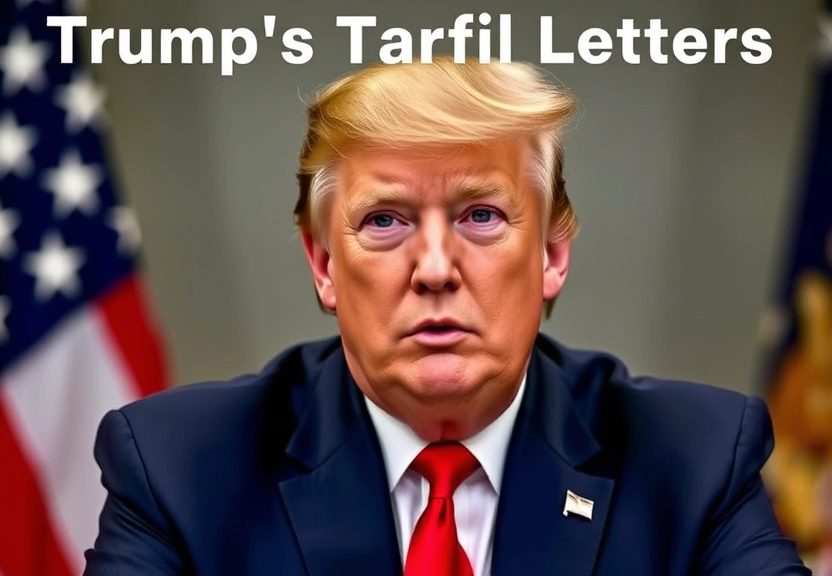Trump’s Tariff Letters: Key Differences from His Previous Threats Unveiled
On a significant Monday, President Donald Trump took a bold step in his trade policy by dispatching tariff letters to several U.S. trading partners. This move, a follow-up to his previous threats regarding tariffs, marks a pivotal moment in his administration’s approach to international trade relations. Starting with Japan and South Korea, Trump’s letters are a clear indication that he is serious about implementing tariffs, and they could have far-reaching implications for global trade dynamics.

In this article, we will explore the key differences between Trump’s recent tariff letters and his previous threats. We will analyze the potential impacts on U.S. trading partners, specifically focusing on Japan, South Korea, and other targeted nations like Malaysia and South Africa. Understanding these nuances is crucial for stakeholders in the global economy, including businesses, economists, and policymakers.
The Context of Tariff Letters
The announcement of tariff letters comes in the wake of ongoing trade tensions between the United States and several nations. Trump’s administration has repeatedly emphasized the need for fair trade practices, which they believe have been compromised by longstanding trade agreements. The tariff letters serve as a formal notification to countries that may be subjected to new tariffs, elevating the seriousness of the discussions surrounding trade imbalances.
Historical Perspective on Trump’s Trade Policy
Since taking office, Trump has adopted a confrontational approach to trade, often utilizing threats of tariffs as a means of negotiation. His administration’s stance has been characterized by a desire to protect American industries and workers from what he perceives as unfair competition. While previous threats were often met with skepticism, the recent letters signal a shift towards tangible actions that could reshape trade relationships.
Key Differences in This Round of Tariff Letters
Several critical differences set Trump’s recent tariff letters apart from his earlier threats. Understanding these distinctions is vital for analyzing their potential impact on international trade.
1. Formality and Implementation
Unlike previous threats, which often came in the form of social media posts or verbal announcements, the tariff letters represent a formalized approach. This shift indicates a commitment to follow through on the proposed measures, making it clear that the administration is moving from rhetoric to action.
2. Targeted Nations
This round of tariff letters is specifically directed at key U.S. trading partners, including Japan and South Korea, as well as Malaysia and South Africa. This targeted approach differs from earlier, broader threats that applied to a wider range of nations without distinction. By focusing on specific countries, the administration may be seeking to negotiate more favorable terms or concessions.
3. Economic Context
The current global economic landscape is different from when previous threats were made. With the COVID-19 pandemic affecting economies worldwide, countries are more vulnerable than ever. The timing of these letters suggests that Trump may be attempting to leverage this vulnerability to achieve his objectives.
4. Potential Legislative Backing
There is also a possibility that Trump’s administration is seeking legislative support for these tariffs, which could provide a stronger foundation for their implementation. This contrasts with previous threats, which were often unilateral and lacked Congressional endorsement.
Implications for U.S. Trading Partners
The implications of Trump’s tariff letters extend beyond mere policy changes; they could have significant economic ramifications for the targeted countries. Here are some of the potential impacts:
- Increased Costs: Tariffs typically lead to higher costs for imported goods, which can affect consumers and businesses alike.
- Retaliation: Affected countries may respond with their own tariffs, leading to a tit-for-tat scenario that could escalate trade tensions.
- Supply Chain Disruptions: Companies with global supply chains may experience disruptions as they navigate new tariffs and trade barriers.
- Market Volatility: Financial markets may react negatively to uncertainty surrounding trade policies, affecting investment and economic stability.
- Long-term Relationships: Trust and cooperation between the U.S. and its trading partners may be undermined, complicating future negotiations.
Response from Japan, South Korea, and Other Countries
The immediate responses from countries like Japan and South Korea will be crucial in determining the next steps in this trade saga. Both nations have historically maintained strong economic ties with the United States, and their reactions could set the tone for how other countries respond to the tariff letters.
Japan’s Position
Japan has long been a key ally of the U.S., and its economy is intricately linked to American markets. However, the Japanese government may be compelled to reassess its trade strategies in light of the new tariffs. Possible responses could include negotiating new trade agreements that provide greater protections for Japanese industries.
South Korea’s Strategy
Similarly, South Korea has also relied on trade with the U.S. to bolster its economy. The South Korean government may seek to engage in diplomatic talks aimed at mitigating the impacts of the tariffs, potentially exploring avenues for negotiation that could avert a trade war.
Frequently Asked Questions (FAQs)
1. What are the main objectives of Trump’s tariff letters?
The primary objectives are to address perceived trade imbalances and protect American industries from what the administration considers unfair competition from foreign countries.
2. How do tariffs affect consumers?
Tariffs generally lead to higher prices for imported goods, which can ultimately be passed on to consumers in the form of increased prices for everyday products.
3. Will other countries retaliate against U.S. tariffs?
It’s possible that affected countries may implement their own tariffs in response, leading to potential trade wars that could escalate tensions further.
4. How can businesses prepare for potential tariffs?
Businesses should assess their supply chains, consider diversifying their sourcing strategies, and stay informed about changes in trade policies to mitigate the impacts of tariffs.
5. What are the long-term implications of these tariff letters?
The long-term implications could include strained relationships with trading partners, disrupted supply chains, and potential shifts in global trade dynamics as countries adjust to new tariffs and trade barriers.
Conclusion
President Trump’s recent tariff letters represent a significant evolution in his administration’s approach to international trade. By moving from threats to formal notifications, he has signaled a commitment to implementing tariff measures that could reshape economic relationships with key trading partners like Japan, South Korea, Malaysia, and South Africa. The potential economic implications are vast, affecting consumers, businesses, and global markets alike.
As the world watches closely, the responses from these nations will be critical in determining the future landscape of trade. Stakeholders must remain vigilant and informed as these developments unfold, preparing for the possible repercussions of Trump’s aggressive trade policies.
📰 Original Source
Este artigo foi baseado em informações de: https://www.marketwatch.com/story/trumps-tariff-letters-are-hitting-heres-how-they-differ-from-his-earlier-threats-94a9e58a?mod=mw_rss_topstories


